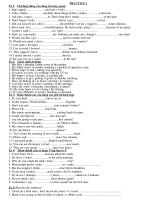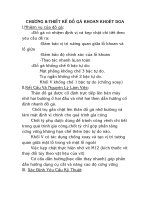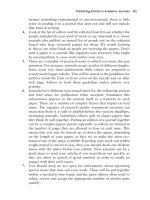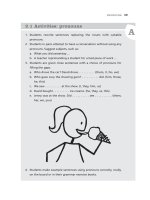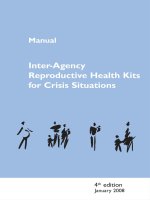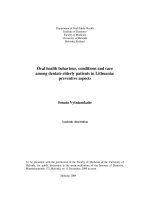Smile Smarts! AN ORAL HEALTH CURRICULUM FOR PRESCHOOL - GRADE 8 docx
Bạn đang xem bản rút gọn của tài liệu. Xem và tải ngay bản đầy đủ của tài liệu tại đây (1.82 MB, 81 trang )
••
FLEXIBLE, MODULAR LESSON PLANS
••
SUPPORT MATERIALS
••
HANDS-ON CLASSROOM DEMONSTRATIONS
••
STUDENT ACTIVITY SHEETS
••
SUGGESTIONS FOR FURTHER ORAL HEALTH ACTIVITIES
Smile Smarts!
AN ORAL HEALTH CURRICULUM FOR PRESCHOOL - GRADE 8
SHINING SMILES!
Grades Preschool – 1 (Ages 4-7) 1
A LIFETIME OF HEALTHY SMILES!
Grades 2 – 3 (Ages 7-9) 11
TEETH TO TREASURE!
Grades 4 – 6 (Ages 9-12) 23
WATCH YOUR MOUTH!
Grades 7 – 8 (Ages 12-14) 35
Table of Contents
1
Shining Smiles!
LESSON PLAN
GRADES PRESCHOOL THROUGH 1 (AGES 4-7)
Shining Smiles! helps children ages 4 through 7 develop good oral health
habits that can last a lifetime! This program from the American Dental
Association (ADA):
•
Helps children ages 4 through 7 understand the importance of
their teeth.
•
Provides basic information, appropriate to their age and experience,
about keeping teeth clean and healthy.
•
Introduces the dentist as a friendly doctor who helps them take
care of their teeth.
Shining Smiles! Gives you tools that can help you teach students
the fundamentals of good oral health care:
•
A flexible, modular lesson plan
•
Support materials
•
Hands-on classroom demonstrations
•
Student activity sheets
•
Suggestions for further dental health activities
Shining Smiles! is also a valuable teaching tool for teachers, dentists,
hygienists, school nurses, physicians and other health care professionals.
2
MESSAGE TO THE TEACHER OR CLASSROOM PRESENTER
Shining Smiles! is a flexible oral health education program that can be used as a stand-alone
lesson or to supplement your existing health curriculum. It is a valuable teaching tool for
teachers, dentists, hygienists, school nurses, physicians and other health care professionals.
Shining Smiles! is divided into three modules:
Module 1: “Tiny Teeth Do Big Jobs!” approximate time: 10 minutes
Module 2: “Keeping Teeth Bright and Healthy” approximate time: 10 minutes
Module 3: “A Visit to the Dentist” approximate time: 10 minutes
The lesson objectives, key messages, and discussion topics can be presented as three separate
10-15 minutes lessons, in one half-hour session, or supplemented with extra activities and
discussions to serve as an on-going lesson on dental health. This allows you to choose the
method that will work best with the students. The lesson plan is loosely scripted with
discussion questions, explanations and activities that you can easily adapt to your own
unique style of teaching.
HOW SHINING SMILES! WILL HELP YOUR STUDENTS
This program, developed by the American Dental Association (ADA), will:
• Help your young students understand the importance of their teeth.
• Provide basic information about keeping teeth clean and healthy that is appropriate
to their age and experience.
• Introduce the dentist as a friendly doctor who helps them take care of their teeth.
SHINING SMILES! LESSON OBJECTIVES
There are three objectives for this program that can be easily reinforced throughout the
school year. Students will learn that:
1. Teeth are an important part of our body.
2. Keeping our teeth clean helps keep them healthy.
3. Visiting the dentist is an important part of having healthy teeth.
BEFORE YOU START
1. Read the lesson.
2. Photocopy Count & Color, Visiting the Dentist and Finders Keepers activity sheets for
the students.
3. Collect the following materials: magazine photo of a smiling adult with a smiling
baby; illustrations, pictur
es, or models of nutritious foods; several different styles
and sizes of new toothbr
ushes; toothpaste.
4. Have the support materials for this unit handy: How to Brush; Primary Tooth
Development; Old and New T
oothbr
ushes; Adult and Child-size T
oothbr
ushes;
Oral Care Calendar.
Shining Smiles!
A classroom lesson in good oral health care, with special activities for
c
hildren in preschool, kindergarten and 1
st
g
rade.
3
Key Message
Teeth are important for eating, talking and having a nice smile.
Student goals
Upon completing this module students will better understand:
• Why people have teeth.
• How we use our teeth.
• How many sets of teeth people get.
Module Topics (with discussion points and questions)
1. Why we need teeth. Who can name something that we do with our teeth? [Discuss
children’s suggestions, which may include talking, eating or chewing, smiling, singing.
Have children talk, chew, and smile and frown at each other.] Today we are going to talk
about a very important part of our bodies — our teeth. Teeth help us do many things.
2. How teeth help us do things better. We have had some good suggestions. But how do
our teeth help us do these things? How do our teeth help us eat? [We can chew our
food into little pieces. This keeps us from choking or getting a stomach ache.]
ACTIVITY #1: What about talking? Is it easy to talk without using your teeth?
Let’
s try it. Say “thirty-three thirsty thieves” without letting your tongue touch
your teeth… That was very hard to do! Our teeth have the important job of
helping our lips and tongue make sounds pr
operly
. I have another question.
Do you think you need your teeth to fr
own? Let’
s test it out. Turn to your
neighbor and give a great big smile Good. Now, give your neighbor a very
unhappy fr
own H-m-m-m. I guess you
don’
t need teeth to fr
own! But since
most of you laugh and smile
a lot
, your teeth are very important!
So now we know that:
Our teeth are important because they help us talk properly,
chew our food and give us beautiful smiles!
3. Characteristics of teeth. What are your teeth like? Are they soft or hard? Do they have
sharp edges or are they round like a ball? Are they strong or do they break easily? [Discuss
answers.] So, our teeth ar
e hard, have some sharp or cutting edges, and are strong. What
would happen if our teeth were soft and weak? [Couldn’t chew; they might break; it would
be har
d to talk.]
Module 1: “Tiny Teeth Do Big Jobs!” 10-15 minutes
4
4. The number and purpose of baby (primary) teeth. When did you get your teeth?
[When you were a baby.] Why do babies need teeth? [To learn how to talk and so
that they can eat solid food.] Now I have a really hard question. How many baby
teeth do children get? Any guesses?
ACTIVITY #2: Primary Tooth Development. Here is a picture that shows all the
teeth in the top of your mouth and in the bottom. Let’s count them together
out loud… Twenty teeth! That’s a lot. By the time children are three or four
years old, they have 20 teeth.
Children get 20 teeth by the time they are 3 or 4 years old.
5. Sets of teeth in a lifetime. Will you have these 20 teeth your whole life? [No.] What
happens to your teeth when you get to be 5, 6 or 7 years old? [Your teeth start to
come out.] Yes, your baby teeth start to come out. Why do you lose your baby teeth?
[As children get bigger they need bigger, stronger teeth.] (First grade teachers may want
to discuss losing primary teeth and getting permanent teeth in more detail. Visit
www
.adacatalog.org for supplemental materials.)
ACTIVITY #3: Look at the size and number of teeth in the photo of the
smiling adult and baby. Ask children to imagine all those big teeth in the
baby’s little mouth. (Use to illustrate why we need baby teeth.) Talk about
things that babies cannot do because they don’
t have many teeth.
6. Permanent teeth. When you get older, your 20 baby teeth will be replaced by 32
permanent teeth. Your permanent teeth are bigger and stronger than your baby teeth.
After all, they are made to last the rest of your life!
People get two sets of teeth during their life: baby teeth
(or primar
y teeth) and adult teeth (or permanent teeth).
Summary: T
eeth are a special par
t of our body and do several ver
y impor
tant jobs
throughout our lives.
5
Module 2: “Keeping Teeth Bright and
Healthy”
approximate time: 10 minutes
Key Message
Cleaning our teeth helps keep them strong and healthy.
Student goals
Upon completing this module students should know:
• That having clean teeth is an important part of having a clean body.
• Basic brushing techniques.
• What plaque is.
• What a cavity is.
• Why eating nutritious foods is important for our teeth.
Module Topics (with discussion points and questions)
1. Keeping our bodies and teeth clean. What are some of the things you do to keep
yourself clean? [bathe, wash hair, wash clothes.] Why is it important to have clean hands,
and to take a bath, and to wash our clothes? [So you don’t get sick; so you look and
smell nice.] How do you feel when you are clean? [Skin smells good, hands don’t feel
sticky, etc.] Can someone be really clean if their mouth and teeth are not clean? [No.]
Why not? [Because a clean mouth feels nicer, your breath smells nice, etc.]
Clean teeth and mouth are parts of a clean body.
2. Brushing teeth. What can you do to keep your teeth clean and healthy? [Brush your
teeth.] How many of you brush your teeth? Great! How often should you brush your
teeth? [Twice a day.] What do you put on your toothbrush? Yes, toothpaste. Why do you
use toothpaste? [Cleans better than just water, gets the food off your teeth, makes your
teeth stronger, makes your mouth taste good.] Those are all good answers. Does anyone
know how much toothpaste you should put on your toothbrush? [Listen to a few
suggestions.] You might be surprised, but you only need a very little bit of toothpaste on
your toothbrush — about the size of a little green pea. [Demonstrate putting a pea-sized
amount of toothpaste on a toothbr
ush.] I have a very important question. When you are
brushing your teeth, what do you do with the toothpaste in your mouth? Yes. Spit out
all the toothpaste! Don’t swallow it. Toothpaste is for cleaning your teeth, not your
stomach!
Brush twice a day with a fluoride toothpaste.
Always spit out all the toothpaste.
6
3. Brushing techniques. Your mom, dad or another grown-up may help you brush your
teeth, or maybe your dentist showed you how to brush. Move the brush back and forth
gently in short strokes. Brush the top, front, and back sides of each tooth.
[NOTE: Ideally, an adult will brush and floss a child’s teeth until he or she is at least 6 years
old. By age 6 or 7, children should be able to brush their own teeth twice a day – with
supervision until about age 10 or 11, to make sure they are doing a thorough job. Since
adults at home do not always supervise tooth brushing, you might want to suggest to your
class that they ask a grown-up to watch them brush, so they can show how well they do it.
Flossing demands more manual dexterity than very young children have, and children are
not usually able to floss well until they are age 10 or 11, and even then they should be
supervised.]
ACTIVITY #4: Here is a picture of one good way to brush your teeth. It says…
(Show How to Brush and read instructions. Ask for questions and comments.)
Move the brush back and forth gently in short stokes.
Brush the top, front and back sides of each tooth.
4. Toothbrushes. What kind of toothbrush do you use? [Get several answers.] I’m going to
ask you a question and give you four answers. You tell me which answer you think is the
right one. [Pass around several different examples of new toothbrushes, or show Adult
and Child-size Toothbrushes.] Here’s the question:
What kind of toothbrush would be easiest for you to use?
a) A very big one
b) One with a fancy handle
c) A small, child-size toothbrush that is easy to hold
d) A purple one
You’re so smart! You should use a small, child-size toothbrush that is easy to hold.
Use a child-size toothbrush that is easy to hold.
ACTIVITY #6: Show Old and New Toothbrushes. Have the children identify
the one that looks new.
Get a new toothbrush when the bristles
are bent and worn out.
7
5. What plaque is. When you brush your teeth at night, they feel clean and your mouth
tastes good, right? Well, if you don’t brush your teeth before going to bed, how does
your mouth feel when you wake up in the morning? [Tastes bad, smells bad, teeth feel
sticky.] That is because there is something else that gets on your teeth besides the food
you eat. It’s called plaque. Can you say “plaque”? Although you can’t see it, plaque is a
sticky film that is forming on your teeth all the time.
Plaque is a sticky, clear film that forms
on your teeth all the time.
6. How plaque contributes to cavities. Plaque is bad for your teeth because it contains
germs. The germs in the plaque can hurt your teeth by helping to make a little hole
called a cavity. What do you think happens if you take a nice strong tooth and put holes
in it? [It isn’t as strong any more.] Right. The tooth gets weaker. Plaque and cavities make
our teeth weaker. That’s why it is so important to brush all the plaque off of our teeth.
How many times a day should you brush? Yes! Two times — in the morning and before
going to bed at night are good times to brush.
7.
Good nutrition. There is another way we can help keep our teeth clean and healthy.
That is by eating and drinking healthy foods. The foods we eat are just as important for
keeping our teeth healthy as they are for keeping our bodies healthy. Eating a mix of
healthy foods for breakfast, lunch and dinner is the best way to keep your teeth and
whole body in good shape. If you are hungry and need a snack, choose foods like fruit,
low-fat cheese, low-fat yogurt, or raw vegetables. If you are thirsty, have a glass of water
or low-fat milk. Don’t drink too much sugary soda or eat too many sweets. If you have
some sweets, try to eat them with your meals.
ACTIVITY #7: Show illustrations or plastic models of nutritious foods and
beverages, or cut pictures of them from magazines. If your class is familiar
with the Food Pyramid, or if you have taught about proper nutrition, you can
use it to review good choices. (Visit www
.mypyramid.gov for more
information.)
Eating healthy foods helps keep your teeth and body healthy
.
Don’t eat or drink too many sweets. If you want sweets,
eat or drink them with your meals.
Now we know how important it is to keep our teeth clean. We should brush two times a
day to keep our teeth clean and remove plaque, and eat healthy foods.
Summar
y:
Keeping our teeth clean and eating healthy foods helps teeth stay healthy
.
8
Module 3: “A Visit to the Dentist”
approximate time: 10 minutes
Key Message
Your dentist is a friendly doctor who will help your teeth stay healthy
and strong.
Student goals
Upon completing this module students should have a basic understanding
of a routine dental visit:
• The role of the dentist
• The roles of the dental helpers (receptionist, assistant and hygienist)
Module Topics (with discussion points and questions)
1. Why it is important to visit your dentist. What is a dentist? [A doctor who takes care of
teeth and mouths.] How many of you have visited your dentist? Why is it important to
visit the dentist? [To make sure your teeth stay healthy and strong.]
2
. The dentist’s office. What interesting things did you see in your dentist’s office? [Discuss
answers, which might include the exam chair, special light, special tools, dental mask
and gloves, etc.] Your dentist has all sorts of interesting things in the office. [Distribute
Visiting the Dentist coloring sheets.] The special chair moves up and down so that people
of different sizes can sit in it, and the dentist can see easily into all their mouths. The
light helps your dentist see into mouths, too. Your dentist also has some other special
things in the office. The little mirror lets your dentist see your back teeth; the “feeler”
tool helps the dentist count your teeth; the x-ray machine takes pictures of the insides
of your teeth; the bib pr
otects your clothing; and ther
e is even a little hose to spray
water into your mouth.
3.
The dental team. What other people might you see at your dentist’s office? Who else
works there? [Receptionist, dental assistant, dental hygienist.] The receptionist works at
the desk and greets you when you come in. The dental assistant helps the dentist by
getting the exam room ready. The dental hygienist also helps the dentist and may clean
your teeth with special cleaners.
4.
The dental exam. What is your dentist looking for when checking your teeth? [Get
several answers.] Yes, your dentist looks for many things. Your dentist counts your teeth,
sees if you are brushing properly, checks to make sure your teeth are growing the correct
way, and looks for cavities. Your dentist also checks your tongue and the inside of your
mouth to make sure they are healthy, too! If you have any questions about your teeth
or
how to take care of them, ask your dentist. Your dentist is a friendly doctor who
wants you to have healthy, shining teeth.
Summary: The dentist is our partner in caring for our teeth.
9
ACTIVITY #8: Have students complete the activity sheets Count & Color and
Finders Keepers.
SUPPLEMENTAL ACTIVITIES
1. Make a bulletin board display from magazine pictures showing things that people
do using their teeth.
2. Have the children sing along with you to the tune “Row, Row, Row Your Boat”:
Brush, brush, brush your teeth, brush them every day.
Keep them bright, make them shine, clean the plaque away.
Brush, brush, brush your teeth, brush them every day.
Front, back, take off the plaque, now we smile all day.
3. Have the children draw pictures of themselves with big smiles. Display the pictures
in your classroom.
4. Invite a dentist to your class. (Dental Organizations often provide a list of speakers.
Visit the Dental Organizations section of ADA.org, to search for a State or Local
Dental Organization nearest you. http://www
.ada.org/ada/organizations/index.asp)
5. For more online classroom resources, visit the Students & Teachers section of ADA.org.
http://www
.ada.org/public/education/index.asp
6. Distribute Oral Care Calendar to students. Create an incentive program for students
who bring in completed calendars.
SUPPORT MATERIALS: CHARTS AND DIAGRAMS
• How to Brush
• Primar
y T
ooth Development
• Old and New Toothbrushes
• Adult and Child-size Toothbrushes
• Oral Care Calendar
STUDENT ACTIVITY SHEETS
• Count & Color
• Visiting the Dentist
• Finders Keepers
Additional educational materials are available for purchase by calling
1-800-947-4746 or by visiting www.adacatalog.org.
10
This page was intentionally left blank.
How to Brush
• Place the toothbrush at a
45-degree angle to the gums.
• Move the brush back and forth
gently in short strokes.
• Brush the outer surfaces, the inside
surfaces and the chewing surfaces
of all teeth.
• To clean the inside surface of the
front teeth, tilt the brush vertically
and make several up-and-down
strokes.
• Brush your tongue to remove
bacteria and keep your
breath fresh.
© 2005 American Dental Association. All rights reserved. Educators and dental professionals are permitted to reproduce and use this activity sheet solely in printed form.
Any other use, duplication or distribution of this activity sheet by any other party requires the prior written approval of the American Dental Association.
Upper Teeth Erupt Shed
Central incisor 8-12 mos. 6-7 yrs.
Lateral incisor 9-13 mos. 7-8 yrs.
Canine (cuspid)
16-22 mos. 10-12 yrs.
First molar 13-19 mos. 9-11 yrs.
Second molar 25-33 mos.
10-12 yrs.
Lower Teeth Erupt Shed
Second molar 23-31 mos.
10-12 yrs.
First molar 14-18 mos. 9-11 yrs.
Canine (cuspid)
17-23 mos.
9-12 yrs.
Lateral incisor 10-16 mos. 7-8 yrs.
Central incisor 6-10 mos. 6-7 yrs.
Primary
Tooth Development
© 2005 American Dental Association. All rights reserved. Educators and dental professionals are permitted to reproduce and use this activity sheet solely in printed form.
Any other use, duplication or distribution of this activity sheet by any other party requires the prior written approval of the American Dental Association.
Old & New Toothbrushes
© 2005 American Dental Association. All rights reserved. Educators and dental professionals are permitted to reproduce and use this activity sheet solely in printed form.
Any other use, duplication or distribution of this activity sheet by any other party requires the prior written approval of the American Dental Association.
Adult and Child-Size
Toothbrushes
Which one would be easiest for him to use?
© 2005 American Dental Association. All rights reserved. Educators and dental professionals are permitted to reproduce and use this activity sheet solely in printed form.
Any other use, duplication or distribution of this activity sheet by any other party requires the prior written approval of the American Dental Association.
© 2005 American Dental Association. All rights reserved. Educators and dental professionals are permitted to reproduce and use this activity sheet solely in printed
form. Any other use, duplication or distribution of this activity sheet by any other party requires the prior written approval of the American Dental Association.
Sunday Monday Tuesday Wednesday Thursday Friday Saturday
Oral Care Calendar
Put a happy face in the box when you brush twice each day.
© 2005 American Dental Association. All rights reserved. Educators and dental professionals are permitted to reproduce and use this activity sheet solely in printed form.
Any other use, duplication or distribution of this activity sheet by any other party requires the prior written approval of the American Dental Association.
Count and Color
Chris has been very busy drawing pictures of toothbrushes!
Count the toothbrushes. Draw a pea-sized ball of toothpaste on each toothbrush.
Color the toothbrushes bright, happy colors!
Visiting the Dentist
© 2005 American Dental Association. All rights reserved. Educators and dental professionals are permitted to reproduce and use this activity sheet solely in printed form.
Any other use, duplication or distribution of this activity sheet by any other party requires the prior written approval of the American Dental Association.
Finders Keepers
Color the things that help you keep your mouth healthy.
© 2005 American Dental Association. All rights reserved. Educators and dental professionals are permitted to reproduce and use this activity sheet solely in printed form.
Any other use, duplication or distribution of this activity sheet by any other party requires the prior written approval of the American Dental Association.
11
A Lifetime of
Healthy Smiles!
LESSON PLAN
GRADES 2 AND 3 (AGES 7-9)
An engaging classroom lesson in good oral health habits for 2
nd
and 3
rd
grade students
A Lifetime of Healthy Smiles! will help your students develop good oral
hygiene habits that can last a lifetime! This program from the American
Dental Association (ADA):
•
Encourages students to think about and discuss the importance
of their teeth.
•
Provides information on good oral health appropriate to their
age and experience.
•
Reinforces dentists’ instructions on properly caring for teeth.
A Lifetime of Healthy Smiles! gives you tools that can help you teach
students the fundamentals of good oral health care:
•
A flexible, modular lesson plan
•
Support materials
•
Hands-on classroom demonstrations
•
Student activity sheets
•
Suggestions for further dental health activities
A Lifetime of Healthy Smiles! is also a valuable teaching tool for
teachers, dentists, hygienists, school nurses, physicians and other health care
professionals.
12
MESSAGE TO THE TEACHER OR CLASSROOM PRESENTER
A Lifetime of Healthy Smiles! is a flexible oral health education program that can be used as
a stand-alone lesson or to supplement your existing health curriculum. It is a valuable teaching
tool for dentists, hygienists, school nurses, physicians and other health care professionals.
A Lifetime of Healthy Smiles! is divided into three modules:
Module 1: “Teeth are Terrific!” approximate time: 8 minutes
Module 2: “Plaque Attack!” approximate time: 7 minutes
Module 3: “YOU Have the Power!” approximate time: 15 minutes
The lesson objectives, key messages, and discussion topics can be presented in as little as
half an hour, or can be supplemented with extra activities and discussions to serve as a full
unit on dental care. This allows you to choose the method that will work best with the
students. The lesson plan is loosely scripted with discussion questions, explanations and
activities that you can easily adapt to your own unique style of teaching.
HOW A LIFETIME OF HEALTHY SMILES! WILL HELP YOUR STUDENTS
This program, developed by the American Dental Association (ADA), will:
• Encourage students to think about, and discuss, the importance of their teeth.
• Provide students with information on good oral health appropriate to their age
and experience.
• Reinforce their dentists’ instructions on properly caring for their teeth.
A LIFETIME OF HEALTHY SMILES! LESSON OBJECTIVES
There are three easy-to-remember objectives for this program. Students will learn:
1. Teeth are important.
2. Healthy teeth are part of a healthy body.
3. Taking good care of our teeth is something that each of us can do.
BEFORE YOU START
1. Read over the lesson plan and choose any of the supplemental activities you wish
to incorporate.
2. Photocopy the A-MAZE-ing Message and Something’s Missing activity sheets
for the students.
3.
Collect the following materials for demonstrations and examples: 1 paper towel; black
crayon or per
manent marker; black water
-based marker; a sponge; a small container
of water; several new toothbrushes in adult and child sizes; dental floss; yarn.
4.
Have the suppor
t materials for this unit handy:
How to Br
ush; How to Floss; Primar
y
Tooth Development; Permanent Tooth Development; Old and New Toothbrushes;
Adult and Child-size Toothbrushes; Oral Care Calendar.
A Lifetime of
Healthy Smiles!
A classroom lesson in good oral health care, with special
activities for 2
nd
and 3
rd
grade students.
13
Module 1: “Teeth are Terrific!” 8 - 15 minutes
Key Message
Teeth are important for eating, talking and having a nice smile.
Student goals
Upon completing this module students will better understand:
• Why their teeth are important.
• Why they are losing baby (primary) teeth and getting adult
(permanent) teeth.
• That adult teeth need good care to last a lifetime.
Module T
opics (with discussion points and questions)
1. Why we need teeth. Today we are going to talk about teeth. We may not think about
our teeth very much, but they help us do a lot of important things. Let’s make a list of
things we can do better with teeth. [Discuss children’s suggestions, which may include
talking, eating or chewing, smiling, singing, playing instruments.]
ACTIVITY #1: How about frowning? Do you need your teeth to frown?
Let’s test it out. Turn to your neighbor and give a great big smile…Good.
Now, give your neighbor a very unhappy frown…H-m-m-m. I guess you don’
t
need teeth to frown! But since most of you laugh and smile a lot, your teeth
are very important!
So now we know that:
Our teeth ar
e important because they help us talk, eat and
give us beautiful smiles!
2. Number of sets of teeth people get. How many sets of teeth do people get in a lifetime?
Does anyone know? [If no one knows, ask if anything unusual has been happening to
their teeth in the past year or so, and help them work out the corr
ect answer.] Y
es.
People get two sets of teeth during their lifetime. Do you know what the first set is
called? [Baby teeth, or primary teeth.] Does anyone know what your new teeth are
called? [Adult teeth, or permanent teeth.] (Show
Primary Tooth Development and
Permanent Tooth Development.)
A person gets two sets of teeth during their life: baby teeth
(or primary teeth) and adult teeth (or permanent teeth).
14
3. The number and purpose of baby (primary) teeth. Here’s an easy question: When did you
get your baby teeth? [When you were a baby!] Why do babies need teeth? [To learn
how to talk and so that they can eat solid food.] Now I have a really hard question. How
many
baby teeth do children get?
Children get 20 baby (primary) teeth.
4. Why children lose their baby teeth. So why are you losing your baby teeth? [As children
get bigger they need bigger, stronger teeth.] How many of you already have some of
your adult teeth? That’s most of you! How are your new adult teeth different from your
baby teeth? [They are bigger].
We lose our baby teeth to make room for our
adult teeth because we need bigger, stronger
teeth to last the rest of our lives.
5. The number of adult (permanent) teeth. Would anyone like to guess how many adult
teeth people get? It’s a lot more than the 20 baby teeth. [Thirty-two.] (Teachers may
want to discuss losing primary teeth and getting permanent teeth in more detail. Visit
www.adacatalog.org
for additional resources.)
You will have 32 adult (permanent) teeth.
6. How long adult teeth should last. How many years will you have your adult teeth?
[Discuss answers.] Many people live to be 80 years old, or older. If all of their teeth have
gr
own in by the time they ar
e 18, then that means that they will need their adult teeth
for at least 62 more years! That’s a very long time.
Your adult teeth are made to last for your whole
adult life if you take good care of them.
Summary: Teeth are a very important part of our bodies. They help us talk properly,
chew our food and have a nice smile.
15
Module 2: “Plaque Attack!” approximate time: 7 minutes
Key Message
Plaque can hurt teeth by making acids that cause cavities.
Student goals
Upon completing this module students should know:
• What plaque is.
• How plaque can harm teeth.
• What a cavity is.
Module Topics (with discussion points and questions)
1. Healthy teeth. Do everyone’s teeth always stay strong and healthy? [Solicit a few stories].
2. Things that prevent teeth from staying healthy. What can happen to teeth that keeps
them from staying healthy? [They get cavities, they can get broken or knocked out.]
3.
What a cavity is. Let’s talk about cavities and what causes them. What is a cavity? [A little
hole in your tooth.]
A cavity is a small hole in a tooth.
4. What plaque is. Does anyone know what causes cavities? [You may get a variety of
answers, but they may not include plaque.] Those are all interesting answers, but there
is one thing that plays a big part in causing decay, or cavities, in your teeth. It is called
“plaque.” [Write “plaque” on chalkboard.] Has anyone heard that word before? If you
do not brush your teeth before you go to bed at night, how does your mouth feel when
you wake up in the morning? [Tastes bad, smells bad, teeth feel sticky or “fuzzy.”]
That
is because plaque has been for
ming in your mouth all night. Plaque is a sticky
,
clear film that is forming on your teeth all the time.
Plaque is a sticky, clear film that is constantly
for
ming on your teeth.
5. How plaque contributes to decay. Plaque is bad for your teeth because it contains germs.
When a person eats or drinks sugary or starchy foods, the sugars and plaque mix together
to make an acid. Does anyone know what acid does? [It makes holes in things.] The acids
in your mouth attack your teeth and can make cavities.
